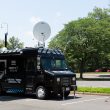Gathering clouds
Once the excitement dies down over the planned nationwide wireless broadband network dedicated to public safety that will deliver data, video and — in time — even voice to first responders, an important question will emerge: Is the next-generation, IP-based network a threat to traditional land mobile radio vendors and dealers that have relied heavily on business from the public-safety sector? Or is it an opportunity?
It’s a question already being mulled by vendors, dealers and analysts.
“With the release of analog TV spectrum in 2009, when the broadcasters complete their migration to digital television, there is a once-in-a-lifetime chance to create a national wireless broadband network for first responders,” said John Facella, director of public-safety markets for M/A-COM. “Since wireless broadband translates into data rates of 1 Mb/s or more, we’re talking about a cellular-style network hardened for public safety.”
That’s not all. Public-safety users would be guaranteed priority on the network, which would be built with a level of redundancy and robustness not found in today’s wireless broadband networks. Features would include backup power and transmission paths to ensure that urgent communications get to their intended destination the first time, every time.
As for the wireless devices that will access the public-safety broadband network, they will be similar to the BlackBerry devices currently being used on commercial wireless networks, according to Facella. “They could be PDA-type devices carried by officers, or PCI cards fitted into patrol car laptops.”
It is so early in the game that the FCC still hasn’t officially named the public-safety licensee that will work with the winner of the D Block auction to build this network. But already, one thing seems crystal clear: A new world has emerged that traditional LMR vendors and dealers might find very foreign.
For instance, it’s possible that equipment and infrastructure procurement for the network will be done via the public-safety licensee — at least on some level — with the help of its adviser, which is in stark contrast to the local procurement — often through dealers — that has been the traditional method of network deployment.
Even if procurement is done on a regional level in some instances because factors such as topography, geography and population density vary so greatly from place to place, the agencies within those regions could band together to form regional buying groups intent on achieving volume discounts.
In addition, wireless broadband devices have not been the province of the LMR sector to date, which means that vendors and dealers both have a lot of catching up to do.
Add it all up, and traditional LMR vendors and dealers likely will find themselves in a strange new world once the buildout of the nationwide wireless broadband network for first responders begins. Just how strange — or harrowing — depends on whom you talk to.
Andrew Seybold, founder and senior partner of Andrew Seybold Inc., a wireless consulting firm in Santa Barbara, Calif., said he’s not even convinced that the network will ever be built.
“There are so many unknowns in this scenario,” Seybold said. “We don’t know yet if there will even be any bidders for the commercial 700 MHz [spectrum] being offered. And even if it does get sold, it will take two to three years for any carrier to build out a 700 MHz network.”
Harlin McEwen, chairman of the Public Safety Spectrum Trust (PSST), a nonprofit organization consisting of FCC-selected public-safety organizations that hopes to serve as the national licensee for the network, said that the shape and form of the network will depend largely on who buys the spectrum and how they plan to roll out their national commercial service.
But he added that he doesn’t see traditional land mobile radio systems going away for a long time. “This is not intended to replace them for the next 10 years,” McEwen said.
M/A-COM’s Facella agreed. “I don’t see wireless data broadband as a replacement for LMR, because LMR networks are built for narrowband voice or lower data speeds and with special features needed by public safety,” he said. “They are two different types of applications, even though voice can be packaged as voice over IP on broadband.”
According to Seybold, current carrier-based technology isn’t a threat to LMR because it is designed to work as a cell-based system.
“Commercial technologies do not support simplex and tactical channels the way LMR systems do,” Seybold said. “Public-safety and municipal users need this functionality — that’s why LMR can’t just be replaced by commercially delivered wireless broadband.”
Commercial technologies also are not designed to support trunking, a must-have for many public-safety agencies.
“Today’s first responders count on trunking not just for effective spectrum management, but to organize their users into various talk groups,” Facella said. “You’re not going to convince public-safety agencies that they should drop all this functionality just for the sake of moving their voice traffic onto broadband wireless.”
And even if most equipment procurement is executed at a national or regional level, that doesn’t mean LMR dealers are in trouble, said Myron Polulak, president of New England Communications Systems. At the least, Polulak sees dealers serving in a subcontractor role, because they are expert in terms of a region’s topography and the needs of its local agencies.
“Dealers also could become channel partners for the distribution of the devices,” he said. “Or they could get involved in service and repair, however they can latch onto it.”
The consensus then is that the next-generation, IP-based network planned for first responders won’t put traditional LMR vendors dealers at risk — at least not for the short term. However, there is no theoretical reason that would prevent commercial carriers from organizing VoIP traffic into talk groups as needed. All that would be required is the right metadata to be attached to each specific VoIP data stream to tell the network server where to route it and who gets to listen. In the same vein, the functionality provided by LMR trunking could be replicated by a clever telecom programmer. It’s just a matter of managing the signal traffic.
This is why some believe that while LMR is not at risk right now, it could find itself being supplanted by broadband wireless in the distant future — but with certain caveats. “That certainly won’t happen for a long time,” McEwen said. “And when it does, there will still be a need for portable, medium- and high-powered transceivers.”
In the meantime, forward-looking dealers should consider offering commercial products in order to build contacts and expertise that later could be leveraged in the public-safety broadband space.
“This represents a great opportunity for LMR dealers to add another revenue line, by offering the specialized public-safety devices that will be used on this network,” Facella said. “There’s also an opportunity for them to study how the mom-and-pop shops sell cellular products and accessories and adopt what makes sense to the public-safety industry.”
Seybold agreed: “LMR can be part of this new future if it wants to be. The key is making sure that they’re included in the distribution channel, so that public-safety agencies will continue to come to them for sales and service.”
According to McEwen, the transition described by Facella and Seybold has precedent. “Broadband wireless is going to change the whole picture of public-safety communications; that’s for sure,” he said. “What remains to be seen is how LMR dealers anticipate, prepare for, and then capitalize on these changes. After all, there was a time when digital radio seemed astoundingly daunting to analog LMR dealers, and yet now they’re selling it.”

















